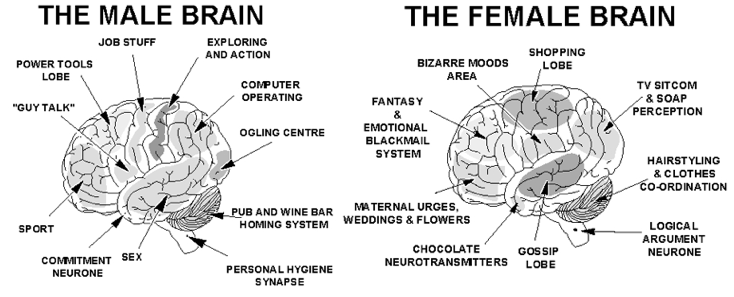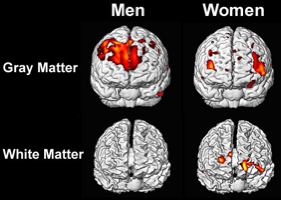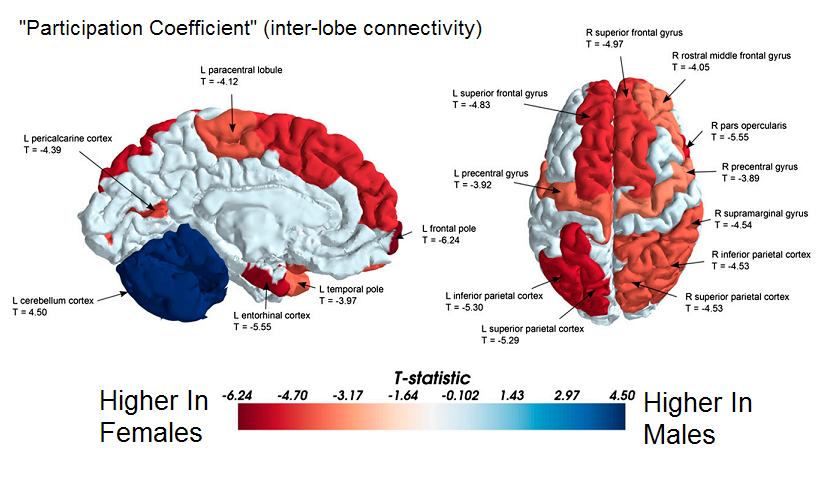

**
I wrote this essay because I'm tired of the lies about boys being better at math and girls needing to naturally do linguistic things. We spend so much time constricting ourselves into senseless gender roles that do more bad than good for society. For greater reference and corroboration, read The Female Brain by pioneering neuropsychiatrist Louann Brizendine, M.D., or check out this site as a starting source, and this as a secondary reference. Enjoy!
First of all, the science of human size dimensions - the genders’ evolutionary, different body frames that is – necessitates certain predisposed functions for the female brain’s intellectual supplementation. That, directionally speaking, refers to women’s smaller brains technically. Specifically, throughout history men have degraded women by citing the smaller size of the female brain as proof of feminine inferiority, given the followed theory corroborated within the animal kingdom: it is consistently indicative species containing progressive, larger brain sizes purport greater intelligence. Needlessly said, though corrective variables of the feminine anatomy say otherwise, history has sequenced this misconceived stigma, perpetuating ignorant beliefs that contradict women’s factually equal intellect.
In reality, the size complex is well-compensated for inside the female brain (and hence, the foremost reason for that 1 % difference entirely): the female brain is drastically compressed suitably, packed increasingly with, for brief example, greater abundances of grey matter, neurons, white cells etc. that are powered by a nine times larger nucleus than males’. Fully, this fluidly normalizes certain discrepancies between the thought procession of men and women respectively. Thus, this leads to problematic, complex gender setbacks: most commonly, one HAZARDOUS misconception infectiously spreads that men are predisposed chemically to be better at math “naturally”; and that sociologically creates an inclined pathway for men to hinder that biological benefit, psychologically enticing men to thus become confident, superior mathematicians while girls shy confidently away in consequence.
Now, is it additionally also presumed women are biologically the automated verbal, superiors, too? Maybe. Complicatedly, this counterpart misconception exists but is weaker in regarding women as more verbally inclined, though “superior-wise” society belief however does extend namely to equalize as the female brain’s superiority, rather. And this differentiation’s existence becomes a hazard in its fallacy’s shortcoming, that which degrades women’s self-esteems in the misconception in the male mathematical intellectuality that does not register the female brain as an equalizer in linguistic intellectuality. Rather too evident is the historical value that ranges men’s language capabilities: the renowned literature speak volumes of great exponential value alone, but more proof than anything else is the summation of appreciable value throughout the repeated, various developments of humanistic communication and cooperation that unarguably derived from the perpetual history (and which coexists modern-day in barely less numbers) of patriarchal societies.
Whosoever could at all propose plausible doubt in the language skills of men when male-dominated histories provided the overwhelming majority of language arts?
The obvious problem with these nonexistent, non-educational beliefs is the created sociological gender roles that compromise unfair, binding expectations on the sexes (especially women), which children learn to uniformly model more rigidly the more they grow older. Specifically speaking, the inclinations regarding talents and especially life professions are inherently instilled early on, making boys and girls to believe in their qualities as based by - or what they are incorrectly told are – the nature of intellectuality that separates the genders. Misconceiving math and science to be within the realm of near incapability for women, men alone have the freedom to logically embrace almost any field of individual desire without fear of social disappointment from his family and community. Conversely, women even today – that is, in a time when they outnumber their male counterparts on the collegial field – centralize in the proximity of what society’s appropriated for them. (The range of limitations namely including medicine, law, real estate, teaching and so forth, which all succeed to discourage women from police work or construction or anything that is deemed “unwomanly”; most detrimental are these preventive, social disinclination at their heightening success which has lowered women to less confident assurance that they themselves are simply “unsuited” intellectually for many prestigious worldly professions. Indeed, they are astray from curiosity at a young age away from believing in themselves as evenly competent for many traditionally-male jobs (logically or not after societal, subconscious pushes). By the time of adolescence, these girls are irrespectively mastering cautiousness to not displease social expectancies with zeal for such unconventional, non-feminine professions. Regardless of the many gains women have made fastidiously in recent decades, women are still absent in large numbers in the many prestigious fields which include the supreme module of scientists, mathematicians, CEOs, politicians: so to speak, the small fraction of the highest respected, intellectual innovators comprises a massive disproportion of male domination.
In order to dispel the long establishment of misconstrued facts, first it must be explained carefully with credible studies of math performance in high schools: a critical, very recent study concluded that the total accumulation of states across the US which girls did better in mathematical scores as opposed to boys averaged virtually no superior over-representation overall for either gender. Not withstanding, aren’t the “preconceived” beliefs that expect the consolidation of boys to outperform girls in math presumptuousness based on the scientific genealogy differences in the male brain? Well, the grave mistake derives from flawed beliefs and misconstrued facts about the male and female brain. Returning to the principle of a woman’s smaller body dimension, a difference most apparent is found in her assiduous and simultaneous use of mental processions in both sides of her brain equally; that is pertinent in the respect that in the male brain the left-side of the brain is the focal command center – the rather logistic, spatial hemisphere commanding indeed the mental necessities to solve math – which functions properly because of the male brain’s advantageous, larger physicality.
This is functioned by the brain’s corpus collusum, and because women’s is large they have the ability to execute thought between both the left and right hemisphere quicker. And likewise, in order to meet the male’s brain larger composition, the female brain packs more dendritic connections between the exponential amount of cells fittingly with its compressed, supplementary design.
(See here for the reported study on MSNBC.)
Secondly, this science posits that linguistically women therefore utilize both hemispheres simultaneously; such is one basis to those romanticized misconceptions about women’s language abilities. In theory, provably women may contain this incidental ability to faster collect congruous articulation, but the romanticism reaches point when it is incorrectly assumed this indicates a natural order that men can’t utilize his language abilities equally; it’s rather simple logically - again given the historical flourish of ingenious language arts that predominantly accredited men – that women’s slighted edge simply relates that men’s language skills functionally garners by individualistic, adjusting second nature. However, the reciprocal fact that the male brain’s Alpha left hemisphere can more easily acquire spatial skills is the central force of the patriarchal, male-dominating superiority complex, which double standards overbearingly. In contrast, the converse technical “superiorities” attributed to the female brain usually are acknowledged as slight advantages that seemingly are ineffective in dissimulating boys.
Unarguably, this is apparently the already obvious solution for the lack of girls interested in science and math career – unbiased presentation of gender equality without regarding meaningless tradition. Another large barrier between the sexes is the assumption women are weaker emotionally, when in all honestly it is society that allows women to be openly emotional as need be, and that disallows men from this privilege rigidly. (As statistics prove, this damagingly contributes to men’s smaller likelihood in seeking emotional assistance, which contributes to their four times higher suicide rates.)
Biologically conversing, the amygdala, which controls anxiety, intuition, reaction to heated situations, anger etc, is four times larger in men, explaining the drastically higher amount of violent men as opposed to women (whom are more inclined to diplomatic solutions). Likewise, it is considerably accurate, if leveling differently at everyone’s arbitrary interpretations, that it is also society that allows men’s reactionary, widespread and accustomed violence. However, women’s larger limbic system attunes them more with their emotions, which is why women tend to commit to closer bonds with others, but it also causes stronger reactions to everyday matters. This can lead to preemptive anxiety and sometimes more easily to depression.
On a lighter note, sexually speaking men are reportedly thinking about sex on an average of once every six minutes, whereas women generally may only think about it once a day (though usually for longer). Overall, on a most serious note the subject must be understood as a summation of facts that do provide intriguing contrasts between the sexes’ brains, the identical 99 % composition aside that is the overlying matter of fact. As unarguable as this, focusing on human differences only limits the gender, and in the state of disorientation that the world today faces, it is imperative that men and women forget tired social repressions and work equally together.
**
The Male and Female Brain have always been romanticized for being very different from each other. Some of the differences are better known than others, and it is generally presupposed that the discrepancies separate the sexes’ individual cognition quite distinguishably. However, the primary fact of genealogical science postulates contrarily in actuality: Factually speaking, the male and female brain are actually 99 % identical. Nevertheless, it can be argued efficiently that the 1 % distinction’s rather paramount, though a closer analytical overview can compellingly preclude men and women are far more alike than different.



